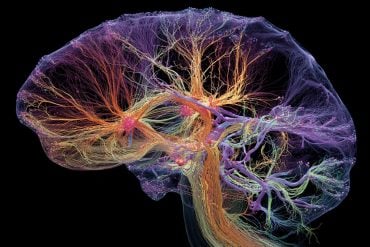Summary: Ants infected with the lancet liver fluke are forced into life-threatening scenarios, all to propagate the fluke’s complex life cycle. Researchers have uncovered that the fluke’s manipulation is even more intricate than previously thought, with temperature serving as a trigger for the ant’s behavior.
At cooler temperatures, infected ants cling to grass blades, heightening their chance of being consumed by grazers. As the temperature rises, the ants climb down, protecting themselves from lethal heat.
Key Facts:
- The lancet liver fluke takes control of an ant’s brain, compelling it to attach to grass blades during cooler periods, maximizing its chance of being consumed by grazers.
- The research revealed a temperature-driven “zombie on/off switch”, controlling when the ant clings to grass or seeks shelter.
- Out of hundreds of flukes inside an infected ant, only one controls the brain, while the rest await transmission in the ant’s abdomen.
Source: University of Copenhagen
Imagine coming-to, jaws gripping the top of a swaying blade of grass, unaware of how you got there. That’s the reality for ants infected with the lancet liver fluke, a tiny parasitic flatworm.
Liver flukes have a complicated, almost insanely conceived life cycle, which begins with the hijacking of the ant’s brain. The unsuspecting ant climbs up and clamps its powerful jaws onto the top of a blade of grass, making it more likely to be eaten by grazers such as cattle and deer.

Researchers from the University of Copenhagen’s Department of Plant and Environmental Sciences have discovered that the parasite’s ability to control the ant is even more cunning than previously believed. Impressively, the parasite can even get the ant to crawl back down the blade of grass when it gets too hot.
“Getting the ants high up in the grass for when cattle or deer graze during the cool morning and evening hours, and then down again to avoid the sun’s deadly rays, is quite smart. Our discovery reveals a parasite that is more sophisticated than we originally believed it to be,” explains Associate Professor Brian Lund Fredensborg, who conducted the study together with former graduate student Simone Nordstrand Gasque, now a PhD student at Wageningen University in the Netherlands.
The study of the parasite has just been published in the scientific journal Behavoral Ecology
Zombie “on/off switch”
The researchers tagged several hundred infected ants in the Bidstrup Forests near Roskilde, Denmark.
“It took some dexterity to glue colors and numbers onto the rear segments of the ants, but it allowed us to keep track of them for longer periods of time,” says Brian Lund Fredensborg.
They then observed the infected ants’ behavior in relation to light, humidity, time of day and temperature. It was clear that temperature had an effect on ant behavior. When the temperature was low, the ants were more likely to be attached to the top of a blade of grass. When the temperature rose, the ants relinquished the grass and crawled back down.
“We found a clear correlation between temperature and ant behavior. We joked about having found the ants’ zombie switch,” says Brian Lund Fredensborg.
Trojan horse
Once the liver fluke infects the ant, several hundred parasites invade the ant’s body. But only one makes its way to the brain, where it can influence the ant’s behavior. The rest of the liver flukes conceal themselves in the ant’s abdomen.
“Here, there can be hundreds of liver flukes waiting for the ant to get them into their next host. They are wrapped in a capsule which protects them from the consequent host’s stomach acid, while the liver fluke that took control of the ant, dies. You could say that it sacrifices itself for the others,” explains Brian Lund Fredensborg.
Animals infected with many liver flukes can suffer liver damage as the parasite moves around the host’s liver and bile ducts.
Nature’s biggest influencer
Brian Lund Fredensborg notes that there are many other examples of parasites that alter animal behavior. As such, parasites that hijack their host’sbehavior have a greater hand in the food chain than many might think. According to Fredensborg, this new study sheds light on an extremely underrated group of creatures.
“Historically, parasites have never really been focused on that much, despite there being scientific sources which say that parasitism is the most widespread life form. This is in part due to the fact that parasites are quite difficult to study. Nevertheless, the hidden world of parasites forms a significant part of biodiversity, and by changing the host’s behavior, they can help determine who eats what in nature. That’s why they’re important for us to understand,” he says.
The tiny liver fluke is widespread in Denmark, and other temperate regions worldwide. The researcher and his colleagues will continue to investigate the parasite, and excactly how it takes over an ant’s brain.
“We now know that temperature determines when the parasite will take over an ant’s brain. But we still need to figure out which cocktail of chemical substances the parasite uses to turn ants into zombies,” Fredensborg concludes.
Box: Liver fluke life cycle
- the zombie ant: The liver fluke infects an ant’s brain causing it to clamp onto a blade of grass so that its next host – a cow, sheep, deer orother grazer – eats it. Meanwhile, a large flock of flukes awaits transmission in the ant’s abdomen.
- The grazer: Once , the grazer ingests an infected ant, it becomes infected with the liver fluke also. The liver fluke that took control of the ant’s brain dies in the host’s stomach acid. The larger flock in the ant’s abdomen is protected by a capsule that only dissolves once in the host’s intestine. Here, the liver flukes find their way through the bile ducts into the liver, where they suck blood and develop into adult flukes that begin to lay eggs, which are then excreted via the host animal’s feces .
- The snail: Once the fluke eggs have been excreted , they lie on the ground waiting for a snail to crawl by and consume the feces. Within the snail, the eggs develop into larval flukes that reproduce asexually, where they can multiply into several thousand.
- The slime ball: To exit the snail and move on to their next host, the larval flukes cause the snail to cough, thereby expelling them in a lump of mucus. Ants are attracted to the ball of mucus and consume it, and in doing so, ingest the fluke larvae.
About this neuroscience research news
Author: Michael Jensen
Source: University of Copenhagen
Contact: Michael Jensen – University of Copenhagen
Image: The image is credited to Neuroscience News
Original Research: Closed access.
“Expression of trematode-induced zombie-ant behavior is strongly associated with temperature” by Brian Lund Fredensborg et al. Behavioral Ecology
Abstract
Expression of trematode-induced zombie-ant behavior is strongly associated with temperature
Parasite-induced modification of host behavior increasing transmission to a next host is a common phenomenon. However, field-based studies are rare, and the role of environmental factors in eliciting host behavioral modification is often not considered.
We examined the effects of temperature, relative humidity (RH), time of day, date, and an irradiation proxy on behavioral modification of the ant Formica polyctena (Förster, 1850) by the brain-encysting lancet liver fluke Dicrocoelium dendriticum (Rudolphi, 1819).
This fluke induces ants to climb and bite to vegetation by the mandibles in a state of temporary tetany. A total of 1264 individual ants expressing the modified behavior were observed over 13 non-consecutive days during one year in the Bidstrup Forests, Denmark.
A sub-set of those ants (N = 172) was individually marked to track the attachment and release of infected ants in relation to variation in temperature. Infected ants primarily attached to vegetation early and late in the day, corresponding to low temperature and high RH, presumably coinciding with the grazing activity of potential herbivorous definitive hosts.
Temperature was the single most important determinant for the induced phenotypic change. On warm days, infected ants altered between the manipulated and non-manipulated state multiple times, while on cool days, many infected ants remained attached to the vegetation all day.
Our results suggest that the temperature sensitivity of the infected ants serves the dual purpose of exposing infected ants to the next host at an opportune time, while protecting them from exposure to high temperatures, which might increase host (and parasite) mortality.






